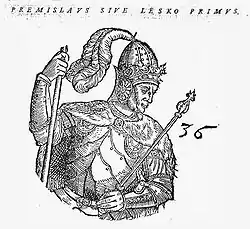
Przemysław (Premislaus), after coronation Leszko I (Lesko, Latin: Lescus), was a legendary ruler of Poland, a goldsmith by trade and soldier who strategically defeated the Hungarians and thus was crowned. He was mentioned by bishop Wincenty Kadłubek (1161–1223) in the Chronica seu originale regum et principum Poloniae (1190–1208). 18th-century historiography dated him to 750 AD,[1] 760–780,[2] or between 750 and 776.[3] James Anderson (1680–1739) claimed he ruled for 20 years.[2]
Story
A goldsmith and soldier, he assembled his friends to attack the powerful Hungarians (and Moravians[1]). He made helmets and breastplates out of tree bark, and enameled them, put them on poles to illude soldiers; the Hungarians supposed they were enemies, and marched towards them. Finding only forests, the Hungarians were surrounded by Premislaus' troops who attacked from all sides. The Hungarians were unable to distinguish the real soldiers from the imaginary, and fled in fear. The captives were slaughtered, and Poland secured freedom. Premislaus took the name Lesko I and ruled peacefully. He died without issue, leaving Poland once again in conflict.
Legacy
A Primislav, wearing a helmet made of oak, was used in Ragusan writer Ivan Gundulić's epic Osman (1589–1638); influenced by the Polish legend.[4]
References
- 1 2 The modern part of An universal history, from the earliest accounts to the present time. C. Bathurst, J. F. and C. Rivington, A. Hamilton, T. Payne, T. Longman, S. Crowder, B. Law, T. Becket, J. Robson, F. Newbery, G. Robinson, T. Cadell, J. and T. Bowles, S. Bladon, J. Murray, and W. Fox. 1783. pp. 331–.
- 1 2 James Anderson (1732). Royal Genealogies, Or the Genealogical Tables of Emperors, Kings and Princes. Bettenham. pp. 406–.
- ↑ Samuel Freiherr von Pufendorf; Jodocus CRULL (1711). An introduction to the history of the principal kingdoms and states of Europe ... Made English from the original High-Dutch. The seventh edition corrected and improved. With an appendix never printed before, containing an introduction to the history of the ... states of Italy, etc. [The dedicatory epistle signed by the translator, J. Crull.]. Dan. Midwinter; Maurice Atkins. pp. 304–.
- ↑ Zdenko Zlatar (1995). The Slavic Epic: Gundulić's Osman. Peter Lang Pub Incorporated. ISBN 978-0-8204-2380-7.
Sources
- Jerzy Strzelczyk (1998). Mity, podania i wierzania dawnych Słowian. Dom Wydawniczy Rebis. ISBN 978-83-7120-688-7.; (2007). ISBN 978-83-7301-973-7.
- Jerzy Strzelczyk (1987). Od Prasłowian do Polaków. Kraków: Krajowa Agencja Wydawnicza. ISBN 83-03-02015-3.
Further reading
- M. Ross (1835). A History of Poland, from Its Foundation as a State to the Present Time. Pattison & Ross. pp. 78–79.
- Dzieje Rzeczypospolitej Polskiej, przez Jędrzejn Moraczewskiego. N. Kamieński. 1862. pp. 1–.
- Augustyn Kołudzki (1727). Thron oyczysty abo Pałac Wiecznosci: w krotkim zebrániu Monarchow Xiązat y Krolow Polskich z roznych approbowanych autorow, od Pierwszego Lecha, az do teraznieyszych czasów, zupełną w sobie życia y dzieł ich niesmiertelnych zamykáiący Historyą. p. 37.